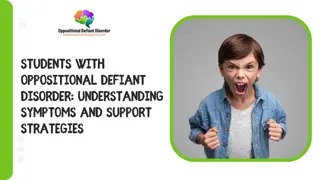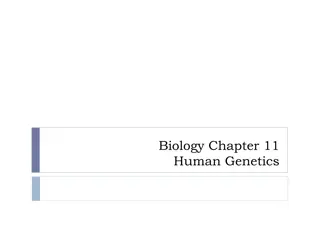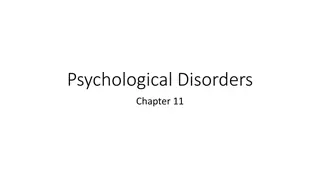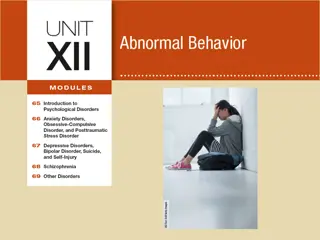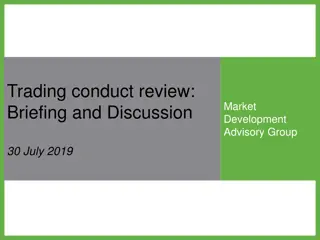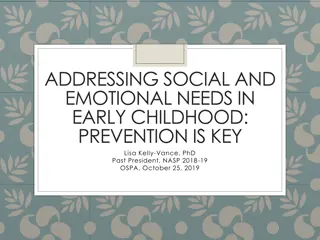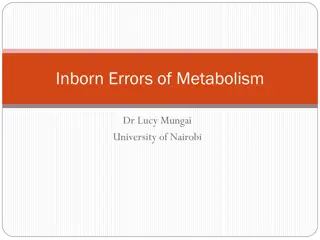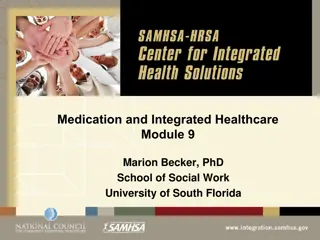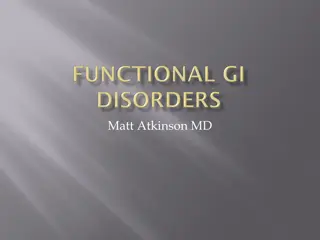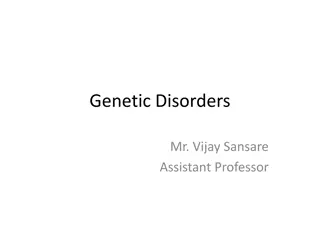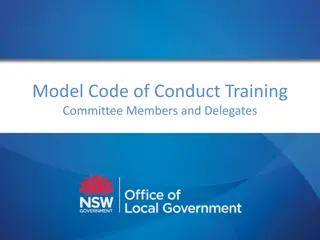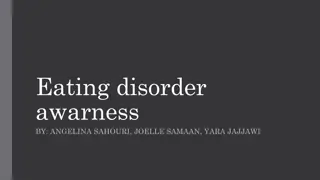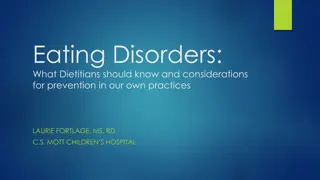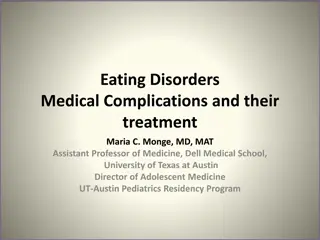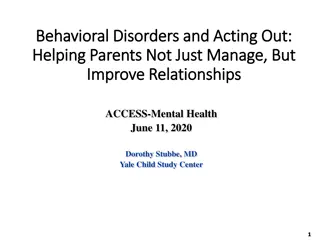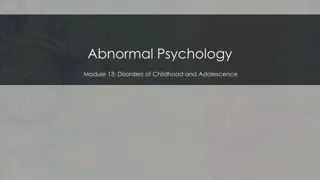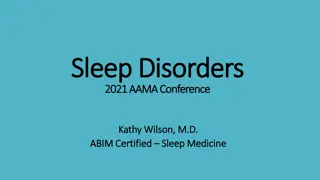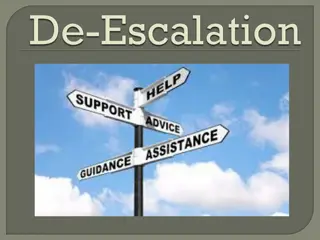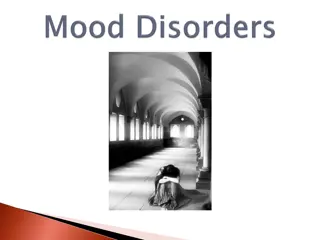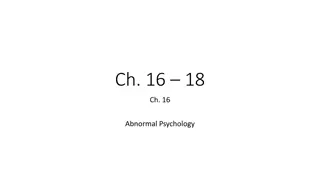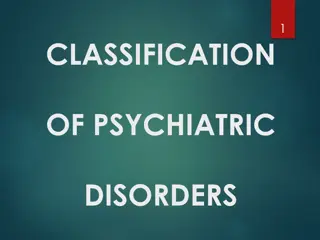Oppositional Defiant and Conduct Disorders
Children and adolescents with oppositional defiant disorder (ODD), conduct disorder (CD), or disruptive behavior disorder (DBD) often display challenging behaviors such as sullenness, argumentativeness, and defiance. These disorders share similarities but also have key differences in terms of behavior patterns, emotional responses, and outcomes. Addressing these issues requires a comprehensive understanding of the varying characteristics and treatment approaches for individuals affected by ODD and CD.
Download Presentation

Please find below an Image/Link to download the presentation.
The content on the website is provided AS IS for your information and personal use only. It may not be sold, licensed, or shared on other websites without obtaining consent from the author.If you encounter any issues during the download, it is possible that the publisher has removed the file from their server.
You are allowed to download the files provided on this website for personal or commercial use, subject to the condition that they are used lawfully. All files are the property of their respective owners.
The content on the website is provided AS IS for your information and personal use only. It may not be sold, licensed, or shared on other websites without obtaining consent from the author.
E N D
Presentation Transcript
IN THE NAME OF GOD IN THE NAME OF GOD IN THE NAME OF GOD
Oppositional Defiant and Conduct Disorders Sara Dehbozorgi Child Psychiatrist
Children and adolescent who are sullen, argumentative, uncooperative, miss school, and lie about their whereabouts, refuse to adhere to curfews, steal money from home, etc. represent one of the largest group of patients seen in child and adolescent mental health settings. They are usually labeled as suffering from oppositional defiant disorder ODD), conduct disorder (CD), or disruptive behavior disorder (DBD). The last term was often used to include also children with ADHD.
Disruptive behavior disorder (DBD) ODD ODD CD CD ADHD ADHD
Individuals with ODD and CD share many characteristics. For example, their conduct is socially unacceptable, they cause disruption or distress to others more than to themselves (i.e., they externalize their problems), and they are more likely to be male and to find it difficult to learn from experience.
Individuals with ODD and CD differ they may be aggressive or not, break the law or not, feel guilt and empathy or not, may be sensation-seeking or not. Children with these problems are heterogeneous in relation to etiology, natural history, response to treatment, and outcome. differ widely from one another:
ICD ICD- -11 11 DSM DSM- -5 5 ICD ICD- -11 11 DSM DSM- -5 5 ) ( ODD ODD ) ( ) ( CD CD IED IED ) ( ASPD ASPD ) ( - 6 9 4 - . 6 ODD ODD . 15 3 . 12 : 6 ( . ) CD CD
( CD CD ODD ODD DSM- -5 5 DSM ) ) ( Conduct disorder ODD ODD ) ( ) ( / (1 (2 (3 (4 (5 (6 (7 (1 (1 (2 (2 (3 (3 / (8 (9 (1 (1 (2 (2 (3 (3 (4 (4 (8 (9 (1 (1 (10 (8 (9 13 13 (10
DSM-5 In DSM-5, ODD and CD have been placed in the chapter Disruptive, Impulse-Control, and Conduct Disorders together with conditions such as intermittent explosive disorder, pyromania, kleptomania, and antisocial personality disorder (ASPD). This grouping seems to assume that these conditions involving problems with self-control that impinge on others are part of a continuum with ODD at one end and ASPD at the other.
DSM-5 In DSM-IV, a diagnosis of CD pre-empted a diagnosis of ODD; this exclusion has been removed in DSM-5. That is, individuals can be diagnosed as suffering from both ODD and CD concurrently. In DSM-5 in a subgroup of anger/irritability and another of argumentativeness/defiance is supported by studies showing that these behaviors tend to occur together and predicted, respectively, internalizing and externalizing behavior later on. The specifier with limited prosocial emotions has been added in DSM-5.
DSM-5 The specifier with limited prosocial emotions has been added in DSM-5. In recent years, there has been a resurgence in interest on the traditionally described as psychopathic traits, in the case of young people often referred to with the term callous unemotional. These youth are described in DSM-5 as with limited prosocial emotions.
DSM-5 This label defines children and adolescents who show lack of remorse and guilt after doing something wrong, appear cold and uncaring, show no concern for the feelings of others, are undaunted by their poor performance at school, and their emotions appear shallow or insincere. They respond poorly to punishment, show lower cortisol levels, seek novel, exciting, and dangerous activities, are prone to boredom, and have lower trait anxiety than other youth with the same level of conduct problems.
DSM-5 DSM-5 highlights that a diagnosis of CD should be made only when the behavior in question is symptomatic of an underlying dysfunction within the individual and not simply a reaction to the immediate social or cultural context. This is to circumvent concerns that a diagnosis of CD may at times be misapplied to individuals in particular settings (threatening, impoverished, high crime, war) where patterns of undesirable behavior could be protective. This does not necessarily imply an absence of CD in those settings, it only means that the context in which symptoms occur needs to be taken into consideration.
EPIDEMIOLOGY ODD and CD are two to three times more prevalent in males than females. Recent surveys (mostly using DSM-IV criteria) in several countries have produced reasonably consistent results ,overall, about 3% of children aged 6 to 18 years met criteria for ODD or CD in the previous 3 or 6 months.
ETIOLOGY Heritability of antisocial behavior has been estimated at about 50%, though it is not diagnosis specific. It appears that what might be transmitted is a general liability to externalizing disorders although there are also disorder- specific liabilities (e.g., for ADHD). Shared environment may specifically influence CD, highlighting the importance of examining shared environmental variables as processes underlying the comorbidity among ODD and CD.
Risk Factors Risk factors include, among others, socioeconomic disadvantage, exposure to family violence and dysfunction, lower IQ, and attentional difficulties. The accumulation of risk may not only act additively, but also multiplicatively. Genetic influences are stronger in children from poor families than in those from affluent backgrounds , genetic factors influence individuals choices and shaping of their own environment .antisocial individuals are more likely to find problematic partners (assortative mating).
* * * * * * * * * * * * * * * * * * * * * * * * * * * * * * * * * * * * * * * * * * * * * * * /
Neuropsychological Aspects Atypical frontal lobe activation, as detected on EEG, is a basis for negative affective style in children with ODD. Positron emission tomography has shown violence to be associated with decreased glucose metabolism in the prefrontal cortex. Orbitofrontal lobe damage has been linked to impulsive aggression. There is a suggested link between aggression and low levels of serotonin in the CNS.
Children with ODD and CD have a lower sensitivity to punishment which may reduce their ability to associate inappropriate behaviors and consequences (the result of impaired fear conditioning, reduced cortisol reactivity to stress, amygdala hyporeactivity to negative stimuli, and altered serotonin and noradrenaline neurotransmission). They also show hyposensitivity to reward, which is mediated by sympathetic nervous system hyporeactivity to incentives, low basal heart rate, orbitofrontal cortex hyporeactivity to reward, and altered dopamine function. Impairment in executive functions suggests poorer control of emotions and decision making.
Comorbidity The most frequent comorbidities are with ADHD (about 10 times more often than expected), major depression (about seven times), and substance abuse (in adolescents, about four times). DSM-5 allows multiple diagnoses to be made (e.g., ODD and CD, ODD and ADHD, CD and major depression). Diagnosis of ODD or CD should not be made if symptoms occur exclusively during the course of a psychotic, substance use, depressive, or bipolar disorder, and the young person does not meet criteria for disruptive mood dysregulation disorder.
Rather than physical attack, females are more prone to use indirect, verbal, and relational violence such as ostracism and character defamation. These behaviors can be difficult to document, are not clearly described as CD symptoms, and may result in underdiagnosis of CD in girls.
Differential Diagnosis ADHD Mood disorders Substance misuse Anxiety disorders Tic disorders Specific developmental and learning disorders Autism spectrum disorders Intellectual disability Disruptive mood dysregulation disorder Intermittent explosive disorder Schizophrenia
Antisocial behavior is not uncommon in the prodromal stage of schizophrenia . It has been suggested that some children with severe impulsivity, hyperactivity, unstable mood, irritability, defiance, and conduct problems may suffer from bipolar disorder, resulting in a higher prevalence of bipolar disorder in this age group.
Developmental Considerations Children s prosocial impulses already become apparent in the first year of life. . A degree of defiance and noncompliance is normal in toddlers, probably reflecting the child s assertiveness and search for autonomy. . Notwithstanding this, toddlers behavior may be indicative of problems when it is too intense, persistent, or pervasive. Distinguishing behaviors that are within the normal range from problematic defiance or noncompliance is difficult at that age.
Developmental Considerations Prosocial behaviors usually increase up to the age of 3 years; a temporary decline then begins to emerge. Defiance and noncompliance, particularly in boys, may also increase about the age of 2 or 3 years. Males report greater involvement in physical fights than females. Aggressive behavior (hitting, biting, smashing objects) is common in 4 to 8 year olds and decreases with age.
Developmental Considerations Severely aggressive acts start after puberty. Covert antisocial actions such as property and status violations (stealing, truancy, running away) increase as children become older, being more prevalent during adolescence. Early adolescence is often associated with an increase in rebellious behavior. Teachers reports indicate that most oppositional symptoms, such as arguing, screaming, disobedience, and defiance, peak between 8 and 11 years and then decline in frequency.
Outcome In some children, ODD symptoms begin in infancy, persist during childhood, and evolve into CD, often after puberty. Other young people show noncompliance and defiance for short periods or do not progress to CD; this may occur more often in females than in males. The continuity between childhood CD and adult ASPD has long been known, so much so that DSM-5 requires evidence of CD symptoms prior to the age of 15 to make a diagnosis of ASPD implying that ODD, CD, and ASPD are part of a dimension of psychopathology.
Outcome Childhood DBDs are associated not only with ASPD but with a wide range of other psychiatric disorders in adulthood (e.g., substance abuse, major depression, psychosis), as well as with many adverse outcomes such as suicidal behavior, delinquency, educational difficulties, unemployment, and teenage pregnancy. Childhood Childhood DBDs often trigger a chain of events that DBDs often trigger a chain of events that increase the likelihood of such unfavorable increase the likelihood of such unfavorable outcomes outcomes
Outcome Studies by and large show a dose response relationship: The higher the number and variety of disruptive behaviors, the worse the adult outcomes. Most adolescents with CD do not develop ASPD in adulthood. A large decline in delinquent and antisocial activities is a commonly reported phenomenon in early adulthood.
Outcome Some data suggest heterotypic continuity between symptoms of irritability (losing temper, being touchy or easily annoyed, angry and resentful) and later internalizing problems, particularly depression. Adolescents with callous unemotional traits are at a higher risk of violent reoffending earlier than their young offender peers.
TREATMENT Children with DBDs are treated with a variety of psychological, behavioral, or pharmacologic approaches, alone or in combination, targeting the child and/or the family. Therapy is of limited effectiveness in the patients with CD typically seen in mental health settings (more chronic, more disturbed, and usually with comorbid conditions). Treatment is more likely to be effective when administered early in the course of the disorder.
Treatment should involve the parents . Improving parenting skills and parent child interactions are core goals. Comorbid conditions (ADHD, depression) ought to be identified and, if appropriate, treated. Parental depression, psychosis, or substance abuse should also be noted and treated. It is very useful to ascertain children s and families strengths and build on them in addition to focusing on their problems.
In ODD, the main goal of treatment is to increase compliance and reduce conflict. The treatment plan should include ways of helping the young person become more cooperative, less argumentative, and be better accepted by peers, often in a family therapy context. Medication should not be offered for the routine management of ODD or CD. In cases of severe aggressive behavior that has not responded to psychosocial interventions, the use of risperidone can be considered in the short term.
Parent Management Training Parent management training (PMT) is based on the principles of operant conditioning and social learning theory. In PMT, parents are encouraged to use positive reinforcement, to adopt more effective discipline strategies, and to learn how to negotiate with their children . PMT has been the most extensively researched therapy in this field.
Multimodal Interventions Multisystemic Therapy (MST) Families and Schools Together (FAST Track)
Individual Interventions Problem-solving skills training ) using various techniques including games, structured activities, stories, modeling, role play, and reinforcement) Assertiveness training Anger control/stress inoculation Rational emotive therapy CBT(small-to moderate effect )
Medication is not a mainstay of treatment of ODD and CD. The dosing strategy of start low, go slow, taper slowly. Before switching, augmenting, combining, or discontinuing medications because of a lack of response, it should be ensured that patients have received an adequate trial (dose and duration) as well as psychosocial interventions. Risperidone for the treatment of aggressive behavior
Stimulants are effective in children with ADHD with oppositional behavior, conduct problems, or aggression. Treatment with atomoxetine, guanfacine, and clonidine may also provide some lesser symptom relief. Caution and careful monitoring should be exercised when prescribing stimulants to adolescents with CD, given the high rate of substance misuse in this population.
PREVENTION Child and adolescent mental health professionals have a critical role in educating the community and political leaders on the advantages of prevention over treatment and retribution, notwithstanding that treatment and law enforcement are important also. Reducing Reducing DBDs is one of the challenges for child mental health DBDs is one of the challenges for child mental health in the in the 21 21st century st century
Addressing conduct problems without tackling the social, family, and individual factors associated with these conditions will lead to disappointment. Treatment of developmental difficulties such as attention and learning problems. Schools can play a key role. Home visitation PMT principles, such as Triple-P
Thanks for your attention Thanks for your attention Thanks for your attention








